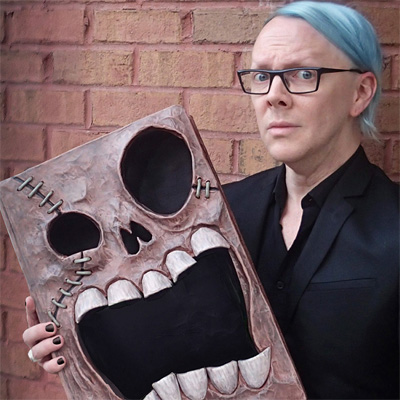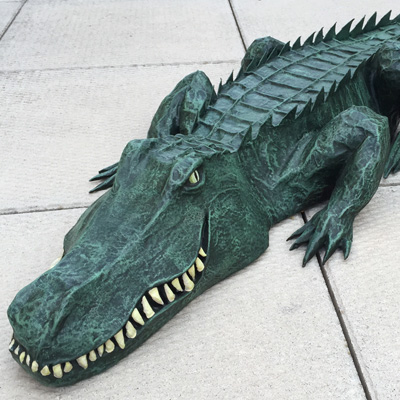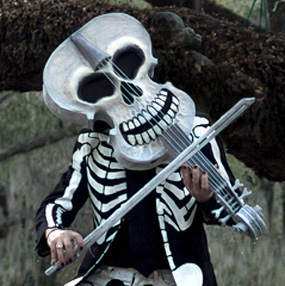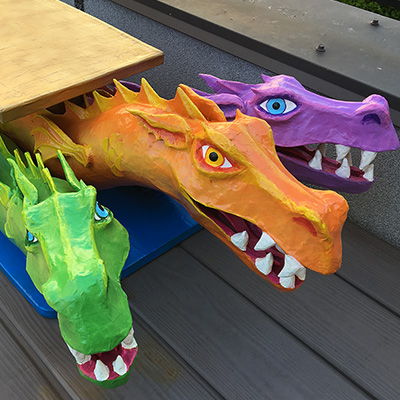Teeth-making tips for big paper maché masks
Published by Manning on October 3rd, 2016
In all of the large paper maché masks and heads I’ve made, the teeth are always, always the most labor-intensive and challenging (and sometimes frustrating!) part. I’m always amazed at what a large proportion of my time and effort go into such a small part of the head! I’ve tried a few different methods for making teeth over the years, with varied success. Here are the methods I’ve used, and some pros and Cons:
1. Plastic spoons
(Example: my first Mardi Gras skull mask)
Method: I cut plastic spoons with heavy duty scissors (make sure to wear goggles for this!) and then covered them in paper maché, let them dry, and glued them onto my mask.
Pros:
- Cheap, easy, and lightweight.
Cons:
- Kind of labor-intensive; it’s a lot of intricate work to get small strips of paper maché to cover the spoons nicely without a lot of creases and ugly angles.
- All the teeth end up being the exact same size and shape. They’re almost too perfectly geometric and uniform; I generally prefer for things to be irregular and organic looking.
- Difficult to place onto a curved surface; because the teeth are so uniformly flat on the back, it’s hard to get them to lay in a natural-looking arrangement on a curved head. The edges of the teeth stick up off the surface of the mask a bit. Not terrible but not ideal.
2. Clay
(Example: my conjoined twins skull mask)
Method: I sculpted the teeth individually out of Activa Plus modeling clay, and laid them into a long thin strip of clay that served as the gumline. The reason for this strip of clay was so that the teeth could be set into dented areas, rather than just lay on the flat surface of the skull.
Pros:
- Easy to work with; very good control over the shape.
Cons:
- Heavy! The clay is much much heavier than paper maché, meaning it’s important to remove it when everything is dry. However:
- Clay is extremely difficult to remove from paper maché! Modeling clay gets very stuck to paper maché, unlike some other materials I work with. For large clay shapes, I use masking tape as a release agent; if you cover a clay shape with masking tape and then cover that with paper maché, you can easily remove the clay and the tape from the inside when you’re all done. But with small teeth, it’s impossible to neatly cover them in tape. So I decided to just wing it and put the paper maché directly onto the clay, and hope for the best. It was kind of a nightmare. In slowly, carefully pulling out the teeth, I tore a lot of little holes in the paper maché, and some of the teeth were so stuck that they pulled the paper maché exterior inside out when I pulled them out! Horrible. I had to do a lot of repair work to the whole area of the teeth once all the clay was removed, and the whole area remained a little bit warped and wrinkled no matter what.
I tried this method again for my cuckoo clock skull mask and had a little better success. While it’s impossible to cover the small clay teeth completely with masking tape, I was able to apply very thin vertical strips of masking tape on the teeth, leaving a little bit of the clay between the teeth exposed. Then when I covered the whole thing with paper maché, it was a little easier to remove the clay afterward, although just as I feared, the paper maché was indeed very stuck to those clay areas between the teeth, and I did a little bit of damage to the paper maché as I pulled the clay out. However, the whole process ended up doing much less harm to the paper maché than what I experienced with the violin skull.
3. Foam insulation tubing, masking tape, paper maché
(Example: the fangs of my my wolf skull mask)
Method: I wrote about these fangs in part 1 of my wolf skull write-up, so take a look there; the fangs are about halfway down the page. I cut out large fang shapes from foam tubing, covered them in masking tape, and then covered them in paper maché. Easy!
Pros:
- Quick and easy!
- Lightweight.
- Good control over the shape and depth.
Cons:
- None really, other than the fact that this method is only really good for very large teeth. It would be impossible to have any fine level of control with this method for smaller teeth.
4. Poster board, craft foam, and tape
(Example: my wolf skull mask)
Method: I wrote about this process in-depth in part 2 of my wolf skull write-up, so take a look there. I cut out poster board shapes for the teeth, added smaller layers of craft foam, covered in tape, and then covered in paper maché.
Pros:
- Lightweight.
- Good control over the shape and depth.
Cons:
- Extremely labor-intensive! I spent an entire day on just these teeth and I wanted to jump out the window! However, the result looks great and the teeth are lightweight enough to leave in the mask base without weighing the whole thing down.
I like the results of this method but I dread ever having to do it again.
Other options!
There’s gotta be a better way, right? I sure hope so. Here are some other things you can try.
- Celluclay. I hate this stuff and have never had any success with it, but you may have better luck. A lot of people love working with it! It dries hard as a rock and is relatively lightweight.
- Paper clay made from shredded toilet paper mixed with wallpaper paste. It doesn’t dry nearly as hard as Celluclay but is easy to work with and extremely lightweight. You’d probably need to cover the finished teeth with tiny strips of paper maché to give them a nice smooth surface.
- Other small, tooth-shaped objects. Candy corn? Is that a terrible idea? With lots of paint and matte spray maybe to keep them from melting/rotting? I bet this is a terrible idea.
- Design a mask with really big teeth! Then they’d be a lot easier to make, and you could use the kinds of base materials that I typically use for larger parts of the skull, e.g. foam board, styrofoam cups, etc, and cover them with paper maché. You can then cut the paper maché open and remove the base materials, just like I do with the rest of the skull. That process would be pretty much impossible for smaller teeth.
- Don’t sculpt, just paint! You can paint your teeth onto a flat surface; I know a ton of people who do that, it looks fine, and honestly in a photo of my mask next to theirs you can’t really even see the difference.
- Or better yet… Do yourself a favor and design a mask that doesn’t even have teeth! Maybe a bird, or a turtle, or an old toothless mummy. You’ll save yourself a lot of hassle! I seriously need to do one of these one day.
Further reading
- My paper maché method for masks, Halloween projects, etc
- My painting method for paper maché masks and other projects
- Making big paper maché masks — advanced tips
- Advanced paper maché mask-making tips, part 2
- Craft materials — choosing the right brands
- Tips for working with foam board for art projects

 About Manning Krull
About Manning Krull How to make a 4-foot paper maché alligator
How to make a 4-foot paper maché alligator My violin skull mask, Mardi Gras 2015
My violin skull mask, Mardi Gras 2015 Three-headed paper maché dragon sculpture
Three-headed paper maché dragon sculpture
November 24th, 2019 at 2:44 am
Hi do u have video or more photos with step by step tutorial on how to make paper mache big head mask? I’m dying to learn pls!! I don’t see much photos in here I would love to learn like how u attach the helmet with the big head?? Etc I want to learn pls thanks
November 25th, 2019 at 1:35 am
Hi MeliSSA! I’m afraid this website contains all the pics and info I have! If you haven’t seen this article, this might be a good starting place: My mask making process — and I also have this one: Attaching a hard hat in a paper maché mask. Good luck!